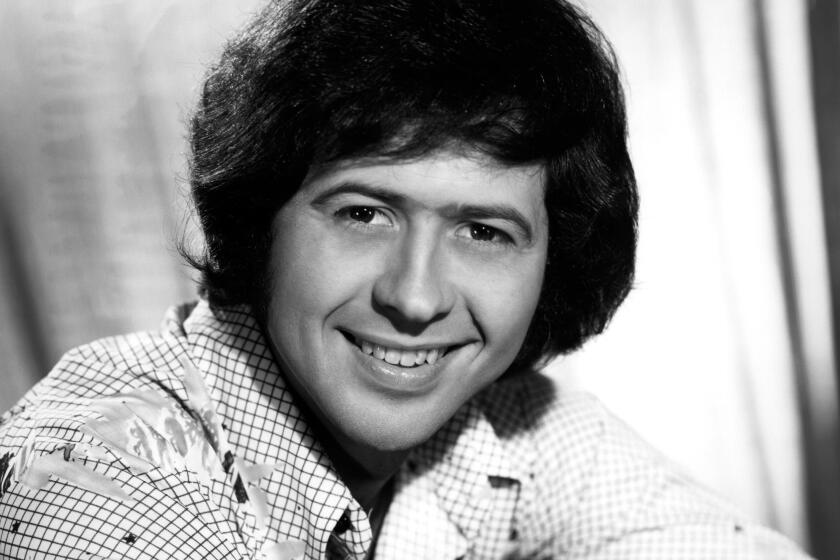Going on Record Again : The catchy melodies of Raymond Scott are being revived as his compositions are re-released on albums.
- Share via
Row after row of old recordings cram the dusty shelves of Raymond Scott’s Van Nuys garage. Thousands of reel-to-reel tapes with yellowing labels compete for space with stacks of vinyl 78s sporting torn, faded jackets.
“These are TV and radio jingles for just about every product you can think of,” said Scott’s wife, Mitzi Scott, gesturing around the dim garage. “GE, Beck’s beer, perfumes, automobiles--he wrote tunes for all of them.”
A few feet away, in an unused guest house, squat the carcasses of aging electronic instruments and musical novelties that have long since been dismantled or fallen into disrepair.
These two rooms hold the legacy of Raymond Scott, 84, once a prolific composer, and bandleader on the radio and television show “Your Hit Parade.” Scott’s work was ended by a series of strokes beginning in 1987 that have left him brain-damaged and nearly unable to speak.
Up until a couple of years ago, the prospects for Raymond and Mitzi Scott’s retirement years did not look good. Scott’s tunes, very popular in his own day, faded by the 1960s and eventually went out of circulation.
“He’d always gotten royalties,” Mitzi Scott said, “but over the years, they got smaller and smaller. I did office work up until a few years ago, when the company I worked for went out of business. We both get Social Security, and we basically lived on that.”
The Van Nuys couple’s future has recently brightened, however, due to a group of music-lovers who discovered Scott’s music a few years ago and set out to get it re-released.
East Coast radio personality Irwin Chusid has taken up Scott’s cause. He first became aware of the musician in 1989, when a Scott fan sent him some music recorded by the Raymond Scott Quintette in the late 1930s. Chusid began playing the music on his eclectic radio show on station WFMU in East Orange, N.J.
“I don’t really care much for Big Band music. It just leaves me absolutely blank,” Chusid said, “but this quintet was music for the 20th Century. It was pop in the best sense of the word: catchy, memorable, with melodies that would just get lodged in your subconscious, and you could not get rid of them.”
Chusid noticed that although he had never heard of Scott, the hard-to-categorize music he was hearing was instantly familiar.
He did some research and found that more than a dozen of Scott’s jazz/pop/classical compositions had been licensed for use in Warner Bros. cartoon soundtracks in 1941 by studio music director Carl Stalling.
Although a handful of animation experts were aware of the Scott/Stalling connection, the frenetic, comic melodies that underscore the antics of Bugs Bunny, Daffy Duck, Elmer Fudd and Porky Pig were never officially credited to Scott.
In fact, Mitzi Scott swears that Raymond never realized his music was being used in “Merrie Melodies” and “Looney Tunes.” Always preoccupied with his latest musical composition or invention, she said, Scott seldom had time for television and never watched a cartoon in his life.
“I was fascinated with this music that seemed to be genetically encoded in the psyche of American minds,” Chusid said. “And I was intrigued by this mystery man who was not credited and barely mentioned in the music history books.
“Whenever I played his music, I’d always get phone calls from people. They loved it; their kids loved it, and they wanted to know how to get it,” Chusid recalled.
Convinced that the cartoon tunes could captivate a whole new generation of listeners, Chusid approached Columbia Records about releasing a Raymond Scott album during the summer of 1989. “There was no interest whatsoever,” Chusid recalled. “I spoke to eight people there, and the responses ranged from ‘There’s no market for him,’ to ‘My father likes Raymond Scott.’ A couple people said, ‘Raymond who?’
Undaunted, Chusid tracked down the Scotts and visited the Van Nuys home. “Raymond was a completely forgotten man. He obviously could not work, and he was living his life in obscurity. The whole thing seemed very tragic,” Chusid said.
He struck a deal with Mitzi to professionally represent the Scotts and quickly went to work promoting the music and making sure Scott was getting credit--and royalties--for his compositions.
After the successful release of an album of cartoon music, “The Carl Stalling Project,” (Warner Bros., 1990) and a musical called “Bugs Bunny on Broadway,” which played the Great White Way in 1991 before touring nationally, Chusid finally got the green light from Columbia to produce a Raymond Scott album.
“We had to drag the metal masters out of Columbia’s vault. I cleaned those discs by hand and transferred them to digital recordings,” Chusid said. The compact disc, featuring 22 short pieces recorded between 1937 and 1940, is called: “The Music of Raymond Scott: Reckless Nights and Turkish Twilights.”
Another album, “The Raymond Scott Project, Volume One: Powerhouse” has been released on the Stash Records label.
Once the music, unavailable for nearly 50 years, was re-released, the Scott revival began to blossom. Mix Magazine columnist “Mr. Bonzai,” a.k.a. David Goggin, heard Scott’s music and immediately fell in love.
“It just knocked me out. I couldn’t believe the music. It’s so playful, yet so unlike anything else, with its strange sounds and rhythms,” Goggin said. “He created his own logic for music. It’s like a dream world. If you step inside it, it all makes sense. If you look at it from the outside, it’s very unusual stuff.”
By all accounts, Scott’s 40-year career was nothing if not unusual.
Born Harry Warnow in 1908 to Russian emigrants who had settled in Brooklyn, N.Y., Scott’s first love was engineering. But his father was an amateur violinist who owned a music shop, and Harry and his brother, Mark Warnow, were exposed to music early on.
Although Harry planned to take engineering courses at Brooklyn Polytechnic, Mark thought his kid brother was too talented to set his music aside. So Mark, who was a violinist and well-paid conductor, bribed Harry to attend the Institute of Musical Art, later the Juilliard School, by paying his tuition and buying him a Steinway grand piano.
When Harry graduated in 1931, he was hired as staff pianist at the CBS radio house band, which Mark conducted. But Harry quickly grew bored with the standard radio repertoire, and he began writing tunes of his own.
The music he composed was quirky, a kind of descriptive jazz that reflected his own eccentric inner world. The musical portraits had titles that gave them away: Trumpet-spooks howl in “New Year’s Eve in a Haunted House,” tom-toms beat menacingly through “Dinner Music for a Pack of Hungry Cannibals,” and a seasick saxophone dominates “Reckless Night on Board an Ocean Liner.”
In 1936, after Harry had picked a new name out of the New York telephone book because it “sounded nice and had good rhythm,” Raymond Scott and his six-member “Quintette” made their network debut. (He said he called the group a quintet, rather than a sextet, because he “liked the sound” of the word.)
Although the music was dismissed by jazz critics as frivolous, Scott’s compositions became instantly popular, and during the 1940s and ‘50s, Scott led the quintet to considerable fame. He also composed a hit Broadway show, “Lute Song,” and worked for a year composing and performing for Hollywood films. He led the Hit Parade show and appeared on other musical television and radio programs.
Although it is hard to believe, listening to his zany, frolicking tunes, his friends and colleagues said Raymond was an intensely serious, quiet fellow who detested performing live and begged out of parties if he could get away with it.
“On ‘Your Hit Parade,’ they showed a camera shot of him at the beginning and the end of the show. He told me he had to have someone stand behind the camera and make faces at him so he could smile during those shots,” Mitzi said.
“He was an Ivory Tower person and a workaholic. Once he got started working, he hated taking time out, even to eat. He was very good with people one-on-one, but not in a crowd,” she said.
His musicians remember well how hard Scott worked them--and himself. “When we were on the road, we’d ask him to go to the movies, but he’d say no,” said former CBS bass player Louis Shoobe. “We’d leave him playing the piano, and when we came back, he’d still be playing the piano. Time meant nothing to him.”
Dave Harris was Scott’s saxophone player. “He was a taskmaster, but only because he was so wrapped up in what he was doing. He didn’t have time for kidding around; it had to be right. . . . He wrote it, and he wanted it played correctly,” Harris recalled.
During the 1950s, as rock ‘n’ roll began to emerge as the new popular music, Scott spent his time composing advertising jingles and indulging his love for engineering by inventing weird electronic instruments.
Among his early inventions was Karloff, a $100,000 sound-effects machine that imitated the sounds of such things as kitchen clatter, jungle drums and a steak frying. Scott used the machine to help out with his ad jingles. His next invention, the Clavivox, was a keyboard instrument that imitated the sound of a human voice by sliding from one note to another without a break.
Long before electronic synthesizers were marketed commercially, Scott had a primitive version of a synthesizer-sequencer in his own commercial recording studio/electronics workshop on Long Island. Mitzi swears he even created an early version of a fax machine in the late 1960s.
But Scott rarely saw any profit from these inventions, partly because he lacked the follow-through to market them, and partly because of his secretive nature, which bordered on paranoia. The one invention that did get him somewhere, his Electronium, with a fantastic instrument panel that lit up like the cockpit of a jet, but no keyboard, sits cannibalized in his garage.
Scott maintained that the Electronium could compose music itself, helped out by a human mind to guide it. The instrument captured the imagination of Barry Gordy Jr., who hired Scott to head Motown Record’s electronic music division in the 1970s. That job brought the Scotts to Van Nuys, where they stayed after Scott retired in 1977.
Even after his retirement, Mitzi said, Scott was constantly composing and tinkering. He took computer classes at Valley College and purchased a home computer in the 1980s, which he modified and then composed on. After his first stroke, when Mitzi tried to access the material he had been working on, she had to have a computer expert discover the passwords and defuse the booby traps that Scott had put into the program to prohibit anyone from tampering with his work or stealing it.
Eventually, 30 pages of music emerged, including his last composition, “Beautiful Little Butterfly,” written in 1986.
Goggin and musician Mark Mothersbaugh, lead singer of the band Devo, have banded together with Chusid and several other animation and music experts to preserve Scott’s musical output.
“This is irreplaceable stuff, and we feel that in 100 years historians will be very curious about this lone genius,” Goggin said.
Mothersbaugh is paying to have Scott’s audiotapes transferred to digital format. The money, he said, is nothing compared to the influence and inspiration Scott has been in his life. “I feel honored to be able to participate in this. I thought of myself at that age and what was going to happen to my archives. I feel it’s very important to protect his intellectual activity before it is gone,” said Mothersbaugh, whose Hollywood company, Mutato Muzika, scores films and television.
This fall, representatives of the Marr Sound Archives at the University of Missouri in Kansas City will be visiting the Scott home to assess the collection and determine how much money will need to be raised to clean, sort and transport the material to Kansas City, where it will be stored in a clean, climate-controlled environment, safe from the ravages of time.
“There’s so much there, it’s like a gold mine, because a lot of it has never been released. Who knows what is going to come out of there that may be appreciated for years to come?” Goggin said.
More to Read
The biggest entertainment stories
Get our big stories about Hollywood, film, television, music, arts, culture and more right in your inbox as soon as they publish.
You may occasionally receive promotional content from the Los Angeles Times.










